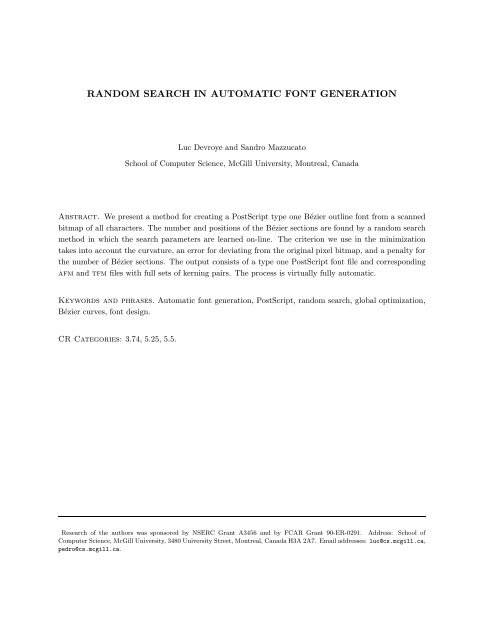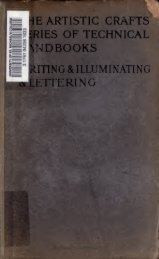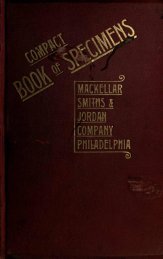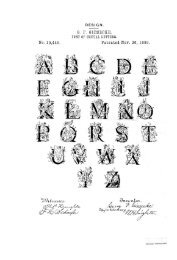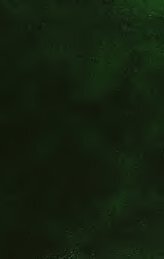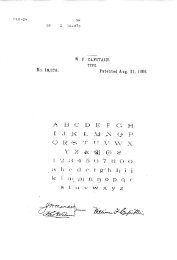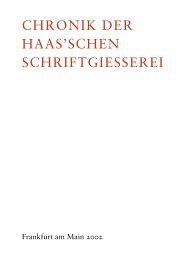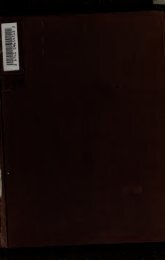random search in automatic font generation - Luc Devroye
random search in automatic font generation - Luc Devroye
random search in automatic font generation - Luc Devroye
You also want an ePaper? Increase the reach of your titles
YUMPU automatically turns print PDFs into web optimized ePapers that Google loves.
RANDOM SEARCH IN AUTOMATIC FONT GENERATION<br />
<strong>Luc</strong> <strong>Devroye</strong> and Sandro Mazzucato<br />
School of Computer Science, McGill University, Montreal, Canada<br />
Abstract. We present a method for creat<strong>in</strong>g a PostScript type one Bézier outl<strong>in</strong>e <strong>font</strong> from a scanned<br />
bitmap of all characters. The number and positions of the Bézier sections are found by a <strong>random</strong> <strong>search</strong><br />
method <strong>in</strong> which the <strong>search</strong> parameters are learned on-l<strong>in</strong>e. The criterion we use <strong>in</strong> the m<strong>in</strong>imization<br />
takes <strong>in</strong>to account the curvature, an error for deviat<strong>in</strong>g from the orig<strong>in</strong>al pixel bitmap, and a penalty for<br />
the number of Bézier sections. The output consists of a type one PostScript <strong>font</strong> file and correspond<strong>in</strong>g<br />
afm and tfm files with full sets of kern<strong>in</strong>g pairs. The process is virtually fully <strong>automatic</strong>.<br />
Keywords and phrases. Automatic <strong>font</strong> <strong>generation</strong>, PostScript, <strong>random</strong> <strong>search</strong>, global optimization,<br />
Bézier curves, <strong>font</strong> design.<br />
CR Categories: 3.74, 5.25, 5.5.<br />
Re<strong>search</strong> of the authors was sponsored by NSERC Grant A3456 and by FCAR Grant 90-ER-0291. Address: School of<br />
Computer Science, McGill University, 3480 University Street, Montreal, Canada H3A 2A7. Email addresses: luc@cs.mcgill.ca,<br />
pedro@cs.mcgill.ca.
1. Introduction.<br />
Design<strong>in</strong>g a typeface is a mammoth undertak<strong>in</strong>g that has fasc<strong>in</strong>ated and absorbed some of the<br />
most creative m<strong>in</strong>ds over the past 500 years. From pioneers such as Garamond, Arrighi, Fournier and<br />
Bodoni to the twentieth-century designers such as Gill and Goudy, we f<strong>in</strong>d one <strong>in</strong>variant—most designs<br />
were based upon simple pen-and-paper draw<strong>in</strong>gs of the characters. Recent efforts <strong>in</strong> computer typography<br />
have attempted to smoothen the transition from such draw<strong>in</strong>gs to a given computer format such as<br />
PostScript or <strong>in</strong>telli<strong>font</strong>. The computer era has seen the creation of parametric <strong>font</strong>s—descriptions<br />
of <strong>font</strong>s as functions of parameters such that each selection of a set of parameters yields another <strong>font</strong> <strong>in</strong><br />
the family. An example is the meta<strong>font</strong> system developed by Knuth (1986a) (see also Hobby (1986)<br />
and Haralambous (1993)). Attracted by the possibility of creat<strong>in</strong>g families of <strong>font</strong>s <strong>in</strong>stead of one <strong>font</strong> at<br />
a time, commercial companies have come up with their own solutions, such as Adobe’s multiple master<br />
format.<br />
In this paper, we are go<strong>in</strong>g back to the basic process of captur<strong>in</strong>g a pen-drawn collection of<br />
characters and mak<strong>in</strong>g just one <strong>font</strong> from it. Our first concern is with the user’s time. The whole process<br />
from scann<strong>in</strong>g to f<strong>in</strong>al output takes less than two (physical) hours and may thus be attractive when one<br />
wants a quick production of one’s own handwrit<strong>in</strong>g. In fact, the design of <strong>font</strong>s for handwritten text is what<br />
motivated us <strong>in</strong> this project. One aspect of this <strong>in</strong>volves the creation of suitably <strong>random</strong>ized characters<br />
to simulate real handwrit<strong>in</strong>g. This won’t be dealt with here—we refer to <strong>Devroye</strong> and McDougall (1996)<br />
for a theoretical development and some crude examples, and to André and Borghi (1989), Doojies (1989)<br />
and van Blokland and van Rossum (1991) for earlier attempts <strong>in</strong> this direction.<br />
In a nutshell, our approach is as follows: first we scan the characters and obta<strong>in</strong> a bitmap. The<br />
bitmap is processed and a polygonal outl<strong>in</strong>e of the characters are found. The polygons are then replaced<br />
by a C 2 Bézier spl<strong>in</strong>e approximation based on Böhm’s method. Thus far, this is all very standard. The<br />
number of <strong>in</strong>itial Bézier sections is typically unacceptably large—often more than 3000—and must be<br />
pared down. After trimm<strong>in</strong>g, the result<strong>in</strong>g outl<strong>in</strong>es lead to PostScript type one (.pfa) files of a size<br />
comparable to those found <strong>in</strong> the market, i.e., about 100k bytes per file.<br />
Our ma<strong>in</strong> contribution here is the method used for trimm<strong>in</strong>g the outl<strong>in</strong>es: the optimization of<br />
the number and the positions of the outl<strong>in</strong>es is done by a <strong>random</strong> <strong>search</strong> algorithm based upon a carefully<br />
picked criterion. Random <strong>search</strong> has several advantages—it is robust, it seeks a global m<strong>in</strong>imum, and it<br />
may be made beautifully adaptive by the <strong>in</strong>troduction of parameters that tune themselves. The algorithm<br />
always produces reasonable results. As our ma<strong>in</strong> contribution is at the level of the optimization itself, we<br />
will keep the discussion of details of the other steps to a m<strong>in</strong>imum. The <strong>in</strong>terested reader can obta<strong>in</strong> more<br />
<strong>in</strong>formation by electronic mail or by consult<strong>in</strong>g Mazzucato (1994). As a first reference on <strong>font</strong> design, we<br />
refer to Karow (1994a, 1994b) or André (1993).<br />
2
2. Bézier curves<br />
The <strong>generation</strong> of scalable <strong>font</strong>s <strong>in</strong> the PostScript type one format requires the use of cubic Bézier<br />
curves <strong>in</strong> order to describe the contours of a character. Bézier curves were <strong>in</strong>vented <strong>in</strong>dependently by de<br />
Casteljau around 1959 and by Bézier around 1962 and are described <strong>in</strong> the books by Far<strong>in</strong> (1993) and<br />
Su and Liu (1989).<br />
Given the current po<strong>in</strong>t (x0, y0), the PostScript command curveto takes the three po<strong>in</strong>ts (x1, y1), (x2, y2), (x3, y3)<br />
as parameters. The four po<strong>in</strong>ts are called the Bézier po<strong>in</strong>ts. The Bézier curve B(t) = (x(t), y(t)) can be<br />
written as<br />
where<br />
Equivalently,<br />
x(t) = axt 3 + bxt 2 + cxt + x0<br />
y(t) = ayt 3 + byt 2 + cyt + y0<br />
ax =x3 − 3(x2 − x1) − x0 ay =y3 − 3(y2 − y1) − y0<br />
bx =3(x2 − 2x1 + x0) by =3(y2 − 2y1 + y0)<br />
cx =3(x1 − x0) cy =3(y1 − y0) .<br />
x(t) = x3t 3 + 3x2t 2 (1 − t) + 3x1t(1 − t) 2 + x0(1 − t) 3<br />
y(t) = y3t 3 + 3y2t 2 (1 − t) + 3y1t(1 − t) 2 + y0(1 − t) 3 ,<br />
<strong>in</strong> the Bernste<strong>in</strong> polynomial format. The monomial form of a Bézier curve allows the computations to be<br />
performed with Hörner’s method. A Bézier curve of the third degree takes one of four possible shapes:<br />
convex convex/concave with one loop with a cusp<br />
Figure 1. Third degree Bézier curves.<br />
The junction po<strong>in</strong>t of the segments is known as a knot or a breakpo<strong>in</strong>t. A spl<strong>in</strong>e S, composed of<br />
two adjacent Bézier curves B0 and B1 may be created as follows. Each curve has its own local parameter<br />
t while S has a global parameter u, where u ∈ R. The knot sequence can be represented <strong>in</strong> terms of the<br />
parameter u, knot i hav<strong>in</strong>g parameter value ui. The correspondence between t and u depends on the<br />
actual length of each segment, t = (u − ui)/(ui+1 − ui). We can th<strong>in</strong>k of B0 and B1 as two <strong>in</strong>dependent<br />
curves each hav<strong>in</strong>g a local parameter t rang<strong>in</strong>g from 0 to 1 or we may regard it as two segments of<br />
a composite curve with parameter u <strong>in</strong> the doma<strong>in</strong> [u0, u2]. Æsthetically pleas<strong>in</strong>g composite curves are<br />
obta<strong>in</strong>ed by <strong>in</strong>troduc<strong>in</strong>g cont<strong>in</strong>uity restrictions and apply<strong>in</strong>g smoothness conditions to S (Mann<strong>in</strong>g, 1974).<br />
3
Roughly speak<strong>in</strong>g, cont<strong>in</strong>uity of the first and second order derivatives at knot po<strong>in</strong>ts with respect to the<br />
global parameter u is called C 1 and C 2 cont<strong>in</strong>uity respectively.<br />
To illustrate these notions of smoothness, take two adjacent Bézier sections B0 (with Bézier po<strong>in</strong>ts<br />
b0, . . . , b3) and B1 (with Bézier po<strong>in</strong>ts b3, . . . , b6). C 1 cont<strong>in</strong>uity at b3, the knot, occurs if b2, b3 and b4 are<br />
coll<strong>in</strong>ear, and if ||b4 − b3||/||b3 − b2|| = ∆1/∆0, where ∆1 = u2 − u1 and ∆0 = u1 − u0. Note that b1 and<br />
b5 do not appear <strong>in</strong> the condition. With C 2 cont<strong>in</strong>uity, the po<strong>in</strong>ts b1, b2, b3, b4, b5 <strong>in</strong>fluence the second<br />
derivative at the junction po<strong>in</strong>t. If the curve S is C 2 then there must a po<strong>in</strong>t d of a polygon b1, d, b5 that<br />
describes the same global quadratic polynomial as the five po<strong>in</strong>ts mentioned above do. Hence assum<strong>in</strong>g<br />
that the curve is already C 1 , the follow<strong>in</strong>g equations must be satisfied <strong>in</strong> order for d to exist:<br />
b2 = (1 − t1)b1 + t1d<br />
b4 = (1 − t1)d + t1b5 ,<br />
where t1 = ∆0/(u2 − u0). The conditions for C 1 and C 2 curves are shown <strong>in</strong> the follow<strong>in</strong>g figure.<br />
b 0<br />
b 1<br />
b 2<br />
Δ0 b3 Δ1 b4 b 5<br />
b 6<br />
b 0<br />
b 1<br />
Δ 0<br />
b 2<br />
d<br />
Δ0 Δ1 Δ<br />
b 1 b4 Δ 3<br />
0<br />
Figure 2. The different segment ratios for C 1 and C 2 Bézier curves.<br />
4<br />
Δ 1<br />
b 5<br />
b 6
3. From bitmap to polygonal outl<strong>in</strong>e.<br />
In the development of a new typeface, typographers are concerned with legibility, uniformity<br />
among the characters and æsthetics. For handwritten characters, however, the major concern is with the<br />
accurate reproduction of the contours. The various steps are shown <strong>in</strong> the simplified figure 3.<br />
(a) (b)<br />
(c) (d)<br />
Figure 3. (a): The <strong>in</strong>itial bitmap. (b): The contour pixels of a<br />
character. (c): The approximation by polygons. (d): Böhm sections<br />
derived from the polygon.<br />
5
The algorithm.<br />
1 Create characters with a pen and paper.<br />
2 Scan the artwork, leav<strong>in</strong>g a tiff bitmap image.<br />
3 Remove impurities from the bitmap.<br />
4 F<strong>in</strong>d all contour pixels (see remark below).<br />
5 Determ<strong>in</strong>e the start<strong>in</strong>g polygonal outl<strong>in</strong>e (see remarks).<br />
6 Trim the start<strong>in</strong>g polygonal outl<strong>in</strong>e (see remarks).<br />
7 Determ<strong>in</strong>e the start<strong>in</strong>g Bézier outl<strong>in</strong>e (see remarks).<br />
Remark. Bitmap formats. A multitude of bitmap formats, such as tiff, gif, eps, bdf and ppm,<br />
are available. The different bitmap formats are, de facto, equivalent. Many programs for convert<strong>in</strong>g from<br />
one format to another are also available. See for example the pbmplus package by Poskanzer (1989).<br />
Remark. Remov<strong>in</strong>g impurities. The bitmap is cleaned by remov<strong>in</strong>g all specks and impurities, small<br />
connected islands of black pixels <strong>in</strong> a white sea and small connected islands of white pixels <strong>in</strong> a black sea.<br />
This is done by f<strong>in</strong>d<strong>in</strong>g all connected components by depth first <strong>search</strong> of the bitmap and remov<strong>in</strong>g those<br />
that are too small.<br />
Remark. F<strong>in</strong>d<strong>in</strong>g all contour pixels. As a character is represented by a bitmap, many black<br />
pixels are required to form the character. Some pixels are “<strong>in</strong>terior” and others constitute the “contour”<br />
of the characters. The latter are extracted. A contour pixel can be def<strong>in</strong>ed as hav<strong>in</strong>g at least one white<br />
pixel as a neighbor <strong>in</strong> a 4-connected representation. Neighbors are sometimes referred to by their relative<br />
position, north, east, south, or west. A pixel can be part of more than one contour and more than<br />
one contour may be present <strong>in</strong> a character. The contour pixels <strong>in</strong> a bitmap can be identified <strong>in</strong> time<br />
proportional to the number of pixels. We mark all black pixels that have at least one white pixel as a<br />
row neighbor or column neighbor. It is convenient to have a representation <strong>in</strong> which contour pixels are<br />
l<strong>in</strong>ked together <strong>in</strong> a cha<strong>in</strong> or cha<strong>in</strong>s. We call the sk<strong>in</strong> of a character the set of white pixels that have a<br />
contour pixel as one of its neighbors. The use of contour pixels <strong>in</strong> conjunction with the sk<strong>in</strong> of a character<br />
permit one very simply to build the desired order<strong>in</strong>g. Some earlier contour-follow<strong>in</strong>g algorithms (Duda<br />
and Hart, 1973) do not create the correct order<strong>in</strong>g for some 8-connected images, so one has to be a bit<br />
careful. Nevertheless, it is rather straightforward to f<strong>in</strong>d ordered contours <strong>in</strong> time l<strong>in</strong>ear <strong>in</strong> the number<br />
of contour pixels. To guarantee that all outl<strong>in</strong>es are found, the visited pixels are marked and the <strong>search</strong><br />
for another outl<strong>in</strong>e can be started by consider<strong>in</strong>g unvisited pixels. The <strong>search</strong> may simply be done by<br />
scann<strong>in</strong>g the bitmap <strong>in</strong> an up-down, left-right fashion. The algorithm resembles <strong>in</strong> some respect depth<br />
first <strong>search</strong> (Cormen, Leiserson and Rivest, 1990).<br />
6
Remark. Other contour-f<strong>in</strong>d<strong>in</strong>g algorithms. Some contour-f<strong>in</strong>d<strong>in</strong>g algorithms are established<br />
accord<strong>in</strong>g to the type of bitmap. For grey-level images, Avrahami and Pratt (1991) developed a contour<br />
extraction algorithm. This algorithm was modified and used <strong>in</strong> Itoh and Ohno (1993). A different<br />
contour-trac<strong>in</strong>g algorithm derived from algorithms designed to verify connectedness of components (M<strong>in</strong>sky<br />
and Papert, 1969) has been employed by Gonczarowski’s algorithm (Gonczarowski, 1991). Algorithms<br />
perform<strong>in</strong>g contour extraction are commonly used <strong>in</strong> the area of pattern analysis and recognition. For<br />
example, Moore’s trac<strong>in</strong>g algorithm (Pavlidis, 1982) works for all bitmap images.<br />
Remark. Polygonal outl<strong>in</strong>e. A simple polygon is a polygon with non-cross<strong>in</strong>g edges. A polygonal<br />
outl<strong>in</strong>e is a f<strong>in</strong>ite collection of non-cross<strong>in</strong>g simple polygons. A po<strong>in</strong>t is <strong>in</strong>side a polygonal outl<strong>in</strong>e if a<br />
ray emanat<strong>in</strong>g from it crosses an odd number of edges (this is called the even-odd rule, see Foley et al,<br />
1992). The start<strong>in</strong>g polygonal outl<strong>in</strong>e of our character has two properties: (i) its vertices are the centers<br />
of some black pixels; (ii) all centers of pixels <strong>in</strong> the orig<strong>in</strong>al bitmap are correctly colored (black pixels<br />
have centers that are <strong>in</strong>side the polygonal outl<strong>in</strong>e). We refer to figure 3(c).<br />
Remark. Trimmed polygonal outl<strong>in</strong>e. The start<strong>in</strong>g polygonal outl<strong>in</strong>e consisted of 800 to 3000<br />
l<strong>in</strong>ear segments <strong>in</strong> our experiments. It may be trimmed by walk<strong>in</strong>g around the contour and identify<strong>in</strong>g<br />
the longest edges that would <strong>in</strong>duce no error on the bitmap. That is, we have a current polygon vertex<br />
vi and consider the polygons <strong>in</strong> which the cha<strong>in</strong>s (vi, vi+1, . . . , vj) are replaced by (vi, vj). The largest<br />
j > i for which the result<strong>in</strong>g polygonal outl<strong>in</strong>e correctly colors all pixel centers is kept, and the attention<br />
moves to vj. This is repeated until the entire contour is processed. There is no absolute guarantee that<br />
the result<strong>in</strong>g polygon is m<strong>in</strong>imal, but it is considerably less complex. The time is roughly l<strong>in</strong>ear <strong>in</strong> the<br />
number of contour pixels.<br />
Figure 4. A portion of the contour is partitioned<br />
<strong>in</strong>to longest possible contiguous l<strong>in</strong>e segments.<br />
Remark. From polygonal outl<strong>in</strong>e to Bézier outl<strong>in</strong>e. In the next step, we make the breakpo<strong>in</strong>ts<br />
of the polygons the def<strong>in</strong><strong>in</strong>g po<strong>in</strong>ts of a Bézier spl<strong>in</strong>e that we shall call a Böhm spl<strong>in</strong>e (Böhm, 1977). Figure<br />
3(d) shows the Böhm spl<strong>in</strong>e for our simple example. It has the same number of sections as the polygon<br />
of figure 3(c). Denote by di the vertices of the trimmed polygonal outl<strong>in</strong>e. Partition each edge (di, di+1)<br />
<strong>in</strong>to three equal parts and denote the two cutpo<strong>in</strong>ts by ui and vi+1 respectively. Let zi be the midpo<strong>in</strong>t<br />
of the segment jo<strong>in</strong><strong>in</strong>g vi and ui: the zi’s are thus the knots of the spl<strong>in</strong>e. The Bézier spl<strong>in</strong>e (a C 2 cubic<br />
B-spl<strong>in</strong>e <strong>in</strong> Far<strong>in</strong>’s notation, Far<strong>in</strong>, 1993) consists of Bézier sections (zi, ui, vi+1, zi+1). Taken together,<br />
7
y the odd-even rule of ray <strong>in</strong>tersections, the Bézier spl<strong>in</strong>es (one for each polygon) def<strong>in</strong>e an <strong>in</strong>side and<br />
an outside. It is of course no longer true that each center of the orig<strong>in</strong>al bitmap is correctly colored.<br />
d 0<br />
d 1<br />
d 4<br />
Figure 5. Böhm’s C 2 construction<br />
algorithm. The white po<strong>in</strong>ts on the<br />
curve are the zi’s.<br />
Our parametrization is called uniform or equidistant. Other parametrizatioons lead to different distributions<br />
of the cutpo<strong>in</strong>ts (Schneider (1990), Itoh and Ohno (1993) and Plass and Stone (1983)). Duplicat<strong>in</strong>g<br />
some of the po<strong>in</strong>ts di creates some sections of zero length. For example, the figure below shows the Bézier<br />
spl<strong>in</strong>es for d0, d0, d1, d1, d2, d2, . . . and d0, d0, d0, d1, d1, d1, . . . respectively. Unfortunately, this procedure<br />
destroys the C 2 cont<strong>in</strong>uity. Our method overcomes the necessity of corner detection and produces a<br />
flexible spl<strong>in</strong>e that is handy to manipulate.<br />
d 2<br />
(a) (b) (c)<br />
Figure 6. C 2 construction with knot multiplicities of 1, 2 and 3 respectively.<br />
8<br />
d 3
(a) (b) (c)<br />
Figure 7. By cutt<strong>in</strong>g Bézier sections <strong>in</strong>to parts, we may obta<strong>in</strong><br />
new <strong>in</strong>terest<strong>in</strong>g spl<strong>in</strong>es. Each section of the Böhm spl<strong>in</strong>e is divided<br />
<strong>in</strong>to three parts, <strong>in</strong> the proportions 0.3, 0.4 and 0.3 for figure (a).<br />
In figure (b), the ratios are 0.1, 0.8, 0.1.<br />
Remark. Other methods of determ<strong>in</strong><strong>in</strong>g Bézier outl<strong>in</strong>es. As knots def<strong>in</strong>e the endpo<strong>in</strong>ts of<br />
curves, dynamic programm<strong>in</strong>g methods may be used to f<strong>in</strong>d a good knot partition<strong>in</strong>g as <strong>in</strong> Plass and<br />
Stone (1983). A modified version of it, presented <strong>in</strong> Schneider (1990), consists of replac<strong>in</strong>g the heuristic<br />
by a subdivision process that breaks the curve where the maximal error occurs. Other approaches<br />
perform first corner detection to def<strong>in</strong>e an <strong>in</strong>itial set of knots (see, e.g., Lejun, Hao and Wah, 1994).<br />
Corner detection consists of <strong>in</strong>terpret<strong>in</strong>g the bitmap to f<strong>in</strong>d locations where the contour changes direction<br />
abruptly. Between two consecutive corners, a certa<strong>in</strong> number of knots may be def<strong>in</strong>ed. An iterative<br />
approach, used <strong>in</strong> Gonczarowski (1991), consists of f<strong>in</strong>d<strong>in</strong>g the longest curve from a given po<strong>in</strong>t such that<br />
it approximates the desired section of the bitmap with a user-specified threshold. As mentioned <strong>in</strong> Itoh<br />
and Ohno (1993), the precise detection of contour po<strong>in</strong>ts is a very hard problem. The algorithm of Itoh<br />
and Ohno uses the estimated corner po<strong>in</strong>ts for def<strong>in</strong><strong>in</strong>g segments. The approximation of contour pixels or<br />
polygonal outl<strong>in</strong>es by curves is sometimes referred to as auto-trac<strong>in</strong>g. Some commercial packages perform<br />
such an operation.<br />
4. Optimization: the quality function.<br />
Call the Böhm spl<strong>in</strong>e S. To further reduce the number of sections and to make smooth outl<strong>in</strong>es<br />
that rema<strong>in</strong> close to the orig<strong>in</strong>al bitmap, one must def<strong>in</strong>e a quality function Φ and an optimization<br />
algorithm. The choice of both differs from what we have found <strong>in</strong> the literature. Our choices are<br />
developed <strong>in</strong> the next two sections.<br />
The most used quality function Φ is based upon the least-squares criterion (see Plass and Stone<br />
(1983), Itoh and Ohno (1993), Gonczarowski (1991) and Schneider (1990)). It evaluates the distance<br />
between the contour pixels and their correspond<strong>in</strong>g locations on the <strong>in</strong>terpolat<strong>in</strong>g curve. It requires the<br />
computation of a mapp<strong>in</strong>g between the pixels and the local parameter t. Different methods are used to<br />
perform the approximation mapp<strong>in</strong>g. Our method does not require any such mapp<strong>in</strong>g. We simply take<br />
the follow<strong>in</strong>g quality function Φ(S) of a spl<strong>in</strong>e S:<br />
Φ(S) = α pixel error(S) + β curvature(S) + γ(# of sections)(S) .<br />
9
Here the weights α, β and γ are nonnegative and sum to one. The pixel error penalizes big differences<br />
with the orig<strong>in</strong>al bitmap. The curvature penalizes curves that arte not smooth. The last term <strong>in</strong> Φ places<br />
a penalty on the description length or complexity of the solution. The first two errors are described <strong>in</strong><br />
more detail.<br />
Pixel error. The pixel error criterion looks at the centers of all pixels <strong>in</strong> the bitmap. The orig<strong>in</strong>al<br />
bitmap colors each pixel. Each center of a pixel gets colored aga<strong>in</strong> by fill<strong>in</strong>g the Bézier spl<strong>in</strong>e ensemble S<br />
accord<strong>in</strong>g to the odd-even rule expla<strong>in</strong>ed earlier. The pixel errors merely counts the number of pixels for<br />
which the colors are flipped. Note that it does not attempt to compute the area of the po<strong>in</strong>ts that are<br />
<strong>in</strong>correctly colored.<br />
Figure 8. The figure shows an org<strong>in</strong>al<br />
bitmap and a Bézier spl<strong>in</strong>e with zero pixel<br />
error. Colors of po<strong>in</strong>ts are determ<strong>in</strong>ed by<br />
the even-odd algorithm.<br />
If we def<strong>in</strong>e the error to be the number of <strong>in</strong>correctly colored pixels, then each pixel has the same<br />
weight <strong>in</strong> the criterion. Experiments show that it is preferable to give more weight to pixels that are<br />
far away from the contour. This, <strong>in</strong> effect, creates better-fitt<strong>in</strong>g spl<strong>in</strong>es. Therefore, we propose various<br />
def<strong>in</strong>itions of pixel error and let the user make a selection. The distance from the outl<strong>in</strong>e is the length of<br />
the shortest adjacent-pixel-path (<strong>in</strong> which only north, south, east, west moves are allowed) start<strong>in</strong>g at the<br />
pixel to reach a pixel of the appropriate color. These distances may be computed by breadth first <strong>search</strong><br />
<strong>in</strong> time proportional to the number of pixels by start<strong>in</strong>g with a queue of contour pixels and work<strong>in</strong>g away<br />
from the contour (Cormen, Leiserson and Rivest, 1990). We will call this the bushfire algorithm. More<br />
details may be found on page 254 of Preparata and Shamos (1985) and <strong>in</strong> Mazzucato (1994). The pixel<br />
error is <strong>in</strong> general def<strong>in</strong>ed by<br />
<br />
W (Dp) ,<br />
all pixels p<br />
where Dp is the distance between p and the nearest pixel for which the orig<strong>in</strong>al bitmap color matches the<br />
assigned color of p. Thus, if p is correctly colored, Dp = 0. In the expression above, W is an <strong>in</strong>creas<strong>in</strong>g<br />
10
penalty function such as<br />
⎧<br />
IU>0<br />
U<br />
⎪⎨ U<br />
W (U) =<br />
⎪⎩<br />
(ord<strong>in</strong>ary pixel error)<br />
(l<strong>in</strong>ear penalty)<br />
2 U<br />
(quadratic penalty)<br />
3 UIU≤δ + ∞IU>δ U<br />
(cubic penalty)<br />
(l<strong>in</strong>ear penalty, ∞ beyond δ)<br />
2IU≤δ + ∞IU>δ U<br />
(quadratic penalty, ∞ beyond δ)<br />
3IU≤δ + ∞IU>δ (cubic penalty, ∞ beyond δ)<br />
,<br />
and δ > 0 is a design parameter. As mentioned above, many exist<strong>in</strong>g algorithms use the least-squares<br />
method. Roughly speak<strong>in</strong>g, these correspond to pick<strong>in</strong>g W (U) = U as the sum of penalties 1, 2, 3, . . . , k<br />
for a pixel at distance k is k(k + 1)/2.<br />
Remark: Updat<strong>in</strong>g the pixel error. We would like to po<strong>in</strong>t out that updat<strong>in</strong>g the pixel error<br />
can be done efficiently. The convex hull property of Bézier curves ensures that all modifications to pixel<br />
color<strong>in</strong>g are relatively local. If a modification θ is applied to a Bézier curve B1 to produce another Bézier<br />
curve B2, the region of the bitmap for which pixels might change color is delimited by the convex hulls of<br />
B1 and B2. Note that the two cannot be disjo<strong>in</strong>t s<strong>in</strong>ce B2 must be attached to the portion of the spl<strong>in</strong>e<br />
that B1 was connected to <strong>in</strong>itially. For simplicity, a bound<strong>in</strong>g box BBθ can be used to enclose the two<br />
convex hulls. With a spl<strong>in</strong>e that gets modified at each step of the <strong>generation</strong> process, the computations<br />
are thus kept to a m<strong>in</strong>imum. The even-odd rule suggests that we should store and keep track of the<br />
<strong>in</strong>tersections between the curves and the horizontal and vertical l<strong>in</strong>es of the pixel grid. Given a Bézier<br />
curve B, with control po<strong>in</strong>ts b0, b1, b2, b3 and a bound<strong>in</strong>g box BB, the <strong>in</strong>tersections of B with the rows<br />
and columns of BB need to be computed. An <strong>in</strong>tersection for B is calculated by solv<strong>in</strong>g the cubic roots<br />
of one of the two polynomials of the Bézier monomial form<br />
axt 3 + bxt 2 + cxt + x0 = xl ayt 3 + byt 2 + cyt + y0 = yl depend<strong>in</strong>g on whether a vertical l<strong>in</strong>e at x = xl or a horizontal l<strong>in</strong>e at y = yl is considered. Note that xl and yl are conta<strong>in</strong>ed <strong>in</strong> the bound<strong>in</strong>g box BB. Without loss of generality, let us consider the case of a<br />
vertical l<strong>in</strong>e at x = xl. We call a root t0, t1, t2 valid, if it is real and falls <strong>in</strong> the range [0, 1]. Let tj be<br />
such a valid root. Then the curve <strong>in</strong>tersects the l<strong>in</strong>e at po<strong>in</strong>t (xl, B(tj)). Let yb = ⌊B(tj)⌋. If the total<br />
number of curves pass<strong>in</strong>g between the po<strong>in</strong>ts (xl, yb) and (xl + 1, yb) is odd then the color of the two<br />
po<strong>in</strong>ts (xl, yb) and (xl + 1, yb) is different. If the considered bitmap is of size r × c, then know<strong>in</strong>g the color<br />
of pixel center (x, y), 0 ≤ x < r, 0 ≤ y < c, as well as the number of times the l<strong>in</strong>e (x, y) (x + 1, y) gets<br />
<strong>in</strong>tersected by curves is sufficient to determ<strong>in</strong>e the color of the pixel (x + 1, y). The only <strong>in</strong>formation that<br />
must be kept for a pixel center (x, y) is thus the number of <strong>in</strong>tersections between (x, y) and (x + 1, y).<br />
The <strong>in</strong>formation that must be reta<strong>in</strong>ed is the set of <strong>in</strong>tersection po<strong>in</strong>ts with the horizontal and vertical<br />
l<strong>in</strong>es.<br />
Curvature. The curvature is a good <strong>in</strong>dicator of the wiggl<strong>in</strong>ess of a curve. For a l<strong>in</strong>e, the curvature is<br />
zero, and for a circle the curvature is constant and is <strong>in</strong>versely proportional to the radius of the circle.<br />
If the curvature at a po<strong>in</strong>t z of a curve C is κ, the curve locally behaves like a circle with radius 1/κ<br />
11
(Swokowski, 1975). In the case of parametrically def<strong>in</strong>ed curves (x(t), y(t)), the curvature at t is def<strong>in</strong>ed<br />
as<br />
κ = |x′ (t)y ′′ (t) − y ′ (t)x ′′ (t)|<br />
[(x ′ (t)) 2 + (y ′ (t)) 2 ] 3 2<br />
and the total curvature is <br />
1<br />
1<br />
0 κ(t)dt or 0 κ2 (t) dt. For our spl<strong>in</strong>es, κ varies cont<strong>in</strong>uously across sections,<br />
so that the <strong>in</strong>tegrations may rout<strong>in</strong>ely be performed by by Simpson’s rule (Davis and Rab<strong>in</strong>owitz, 1984).<br />
5. Optimization<br />
The Böhm spl<strong>in</strong>e <strong>in</strong>troduces a possibly substantial error on the orig<strong>in</strong>al bitmap and has too<br />
many sections. We will optimize both the number of sections and the locations of the Böhm control<br />
po<strong>in</strong>ts (called di above). We recall that these po<strong>in</strong>ts are not endpo<strong>in</strong>ts of Bézier spl<strong>in</strong>es, but rather<br />
def<strong>in</strong>e a closely related Bézier spl<strong>in</strong>e, the Böhm spl<strong>in</strong>e. In the ma<strong>in</strong> part of our algorithm, the number of<br />
sections is reduced and the quality of the approximation is enhanced by m<strong>in</strong>imiz<strong>in</strong>g Φ. As Φ depends <strong>in</strong> a<br />
complicated and multimodal manner on its parameters, and the number of parameters varies as well, we<br />
use a rather robust and general optimization method such as <strong>random</strong> <strong>search</strong>. For general descriptions of<br />
<strong>random</strong> <strong>search</strong>, simulated anneal<strong>in</strong>g, genetic algorithms or evolutionary methods, see Törn and ˇ Zil<strong>in</strong>skas<br />
(1989), Zhigljavsky (1991), Männer and Schwefel (1991), <strong>Devroye</strong> (1994), Rechenberg (1973), Schwefel<br />
(1977, 1981), or R<strong>in</strong>nooy Kan and Timmer (1987a, 1987b). Roughly, we have:<br />
start from S<br />
perform the follow<strong>in</strong>g n times:<br />
T is obta<strong>in</strong>ed from S by modify<strong>in</strong>g S<br />
if Φ(T ) < Φ(S) then S ← T<br />
return S<br />
Random <strong>search</strong> has the advantage that it converges <strong>in</strong> all circumstances to a global optimum, and that it<br />
f<strong>in</strong>ds acceptable solutions relatively quickly. The “modification” def<strong>in</strong>ed <strong>in</strong> the algorithm must be based<br />
upon operations def<strong>in</strong>ed on Böhm spl<strong>in</strong>es. We took two such operations but realize that there are endless<br />
other possibly better operations one might consider as well. Our operations are described below.<br />
The merge operation. A merge operation consists of replac<strong>in</strong>g two adjacent Bézier curve segments<br />
by a s<strong>in</strong>gle one. S<strong>in</strong>ce the C 2 spl<strong>in</strong>e constra<strong>in</strong>t is always present, the merge is executed by replac<strong>in</strong>g two<br />
adjacent sections sj and sj+1 with one, simply by def<strong>in</strong><strong>in</strong>g the new section with the endpo<strong>in</strong>ts of the<br />
polysegment (sj, sj+1). The total number of sections <strong>in</strong> the contour thus decreases by one. This process<br />
is also called knot removal.<br />
12<br />
,
Figure 9. Knot removal: the white po<strong>in</strong>t on the left (a di po<strong>in</strong>t) is deleted,<br />
result<strong>in</strong>g <strong>in</strong> an updated spl<strong>in</strong>e on the right.<br />
The move operation. A move operation moves a section endpo<strong>in</strong>t a certa<strong>in</strong> (<strong>random</strong>) distance away<br />
from its current location, caus<strong>in</strong>g two sections to be modified.<br />
Figure 10. When a po<strong>in</strong>t di is moved, only four Bézier sections of the spl<strong>in</strong>e<br />
are affected.<br />
Consider the Bézier curve segments B0, B1, B2, B3, B4 of a spl<strong>in</strong>e S. If B2 and B3 are merged <strong>in</strong>to B,<br />
only the curves associated with B1, B4 and B need to be recomputed. Similarly if a move is performed<br />
on the junction po<strong>in</strong>t of sections B2 and B3, the affected curve segments are B1, B2, B3, and B4. These<br />
operations ensure the locality of the modifications on a spl<strong>in</strong>e S. A merge operation can perturb the curve<br />
significantly. As it lowers the number of sections <strong>in</strong> a character, the sections become longer. It allows<br />
the removal of small imperfections <strong>in</strong>troduced dur<strong>in</strong>g the <strong>in</strong>put process. The merge is most efficient on<br />
consecutive sections that do have more or less the same orientation.<br />
13
6. Details of our <strong>random</strong> <strong>search</strong> algorithm.<br />
We use the follow<strong>in</strong>g notation. S is a Böhm-type Bézier spl<strong>in</strong>e. A section of a Bézier spl<strong>in</strong>e S<br />
is denoted by B. Its curvature is κ B. Each section also has a priority value π B and the sections are<br />
organized <strong>in</strong>to a heap H with the smallest priority value on top. Furthermore, we need<br />
A. δ1, an <strong>in</strong>itial step size (<strong>in</strong> terms of number of pixels).<br />
B. ξ ∈ {1, 2, 3}, a user parameter for chang<strong>in</strong>g the step size.<br />
C. {pn}, a sequence of adjustable probabilities.<br />
D. N, a limit on the number of iterations.<br />
δ1 ← <strong>in</strong>itial step (<strong>in</strong>itial step size for <strong>random</strong> <strong>search</strong>)<br />
for n = 1 to N do<br />
with probability pn do:<br />
B ← top(H)<br />
B ′ ← shortest section neighbor<strong>in</strong>g B on S<br />
T ← S with B and B ′<br />
merged (and adjacent sections modified)<br />
otherwise do:<br />
select d uniformly and at <strong>random</strong> from<br />
the junction po<strong>in</strong>ts of S<br />
set d ′<br />
← d + δnU, where U is uniformly distributed<br />
on the unit circle (so d ′ − d = δn)<br />
T ← S with d replaced by d ′ (and adjacent sections modified)<br />
if Φ(T ) < Φ(S)<br />
then (a success):<br />
δn+1 ← δn + ξ<br />
S ← T<br />
update H by remov<strong>in</strong>g obsolete sections<br />
and/or alter<strong>in</strong>g the priorities of updated sections<br />
(Note: maximally 4 sections are <strong>in</strong>volved,<br />
and for each one do π B ← κ B)<br />
else (a failure):<br />
δn+1 ← max{1, δn − ξ}<br />
π B ← 1.1 max{π B ′ } for all neighbors B ′<br />
adjust pn as described below<br />
of B<br />
The algorithm above dsiffers from ord<strong>in</strong>ary algorithms <strong>in</strong> two fundamental ways.<br />
A. it uses an adaptive step size. The above algorithm differs from fixed step size <strong>random</strong> <strong>search</strong>, <strong>in</strong><br />
which <strong>random</strong> perturbations are always of constant magnitude. Small step sizes yield small improvements,<br />
14
while large step sizes reduce the probability of a successful trial. As noted by Schumer and Steiglitz (1968),<br />
the optimum step size is between those two extremes. S<strong>in</strong>ce the optimum step size is unknown, adaptive<br />
step size <strong>random</strong> <strong>search</strong> algorithms were created. The magnitude δn of a step <strong>in</strong> a <strong>random</strong> direction<br />
varies accord<strong>in</strong>g to the past experience. The basic pr<strong>in</strong>ciple beh<strong>in</strong>d these adaptive algorithms is to try<br />
bigger steps as an improvement occurs and to reduce the step on unsuccessful trials (Matyas, 1965). Each<br />
algorithm uses a different variant. For example, the adaptive step size <strong>random</strong> <strong>search</strong> algorithm (assrs;<br />
see Schumer and Steiglitz, 1968) tries two step sizes (δn and δn(1 + a)) <strong>in</strong> the same <strong>random</strong> direction,<br />
where 0 < a < 1, and waits a certa<strong>in</strong> number of consecutive unsuccessful trials before reduc<strong>in</strong>g the step<br />
size δn. If on the other hand the attempt succeeds, δn+1 is set to δn or δn(1 + a), depend<strong>in</strong>g upon which<br />
corresponded to the best improvement. A rule of thumb that may be found <strong>in</strong> several publications (see<br />
<strong>Devroye</strong>, 1972, and more recently, Bäck, Hoffmeister and Schwefel, 1991), is that the step size should<br />
<strong>in</strong>crease after a successful step and decrease after a failure, and that the parameters should be adjusted<br />
to keep the probability of success around 1/5. Schumer and Steiglitz (1968) and others <strong>in</strong>vestigate the<br />
optimality of similar strategies for local hill-climb<strong>in</strong>g. Alternately, the optimal step size may be found by a<br />
one-dimensional <strong>search</strong> along a <strong>random</strong> direction (Bremermann, 1968, Gaviano, 1975). Another adaptive<br />
procedure (<strong>Devroye</strong>, 1972) comb<strong>in</strong>es <strong>random</strong> <strong>search</strong> with non-<strong>random</strong> direct <strong>search</strong>. The compound<br />
<strong>random</strong> <strong>search</strong> algorithm (crsa) basically <strong>in</strong>spects a determ<strong>in</strong>istic modification to the approximation as<br />
well as a controlled <strong>random</strong> variation. The <strong>in</strong>terest<strong>in</strong>g feature here is the control of the step size. The<br />
step size δn is updated as follows:<br />
<br />
δn(1 + A) if the trial is successful<br />
δn+1 =<br />
δn(1 − B) otherwise,<br />
where A > 0 and 0 < B < 1. The probability of a successful trial stabilizes roughly around B/(A+B), and<br />
this level must be picked strictly <strong>in</strong> (0, 1/2) (so that A > B). For example, if we choose {success} = 0.2,<br />
then A = 4B. It is recommended though that Psuccess be kept between 0.15 and 0.35. Unfortunately,<br />
this method cannot be employed naïvely. The PostScript type one format requires that the different<br />
<strong>in</strong>struction parameters be <strong>in</strong>teger values (see Adobe, 1990b). Thus, junction po<strong>in</strong>ts are always truncated<br />
to a sufficiently small <strong>in</strong>teger grid. Step sizes less than one just do not make sense. Thus, <strong>in</strong> our algorithm,<br />
step sizes are <strong>in</strong>teger-valued and are updated by the rule<br />
⎧<br />
⎨ δn + ξ if the trial is successful<br />
δn+1 = δn − ξ if the trial is not successful and δn − ξ ≥ 1<br />
⎩<br />
δn otherwise,<br />
where ξ ∈ {1, 2, 3}.<br />
B. it picks the most effective strategy on the fly. In the algorithm, we have a parameter pn<br />
which controls the probability of try<strong>in</strong>g a merge operation. In a sense, the merge operation “competes”<br />
aga<strong>in</strong>st the move operation. After start<strong>in</strong>g with a fixed pn for a warm-up, the algorithm measures the<br />
average decrease <strong>in</strong> Φ observed over the last N ′ = 50 similar operations (this <strong>in</strong>cludes the failed attempts,<br />
<strong>in</strong> which the change <strong>in</strong> Φ is zero). If the absolute value of the average was ∆m for a merge and ∆µ for a<br />
move, then we set pn = ∆m/(∆m + ∆µ) to <strong>in</strong>sure that the more successful strategy receives preferential<br />
treatment. The case 0/0 is elegantly avoided by stopp<strong>in</strong>g altogether when both ∆’s are zero; this only<br />
occurs if no improvement is seen <strong>in</strong> Φ <strong>in</strong> the last N ′ attempts with either strategy. We resorted to<br />
such a rule as it was very difficult to estimate the number of required iterations beforehand <strong>in</strong> view of<br />
the unknown nature of the characters—simple outl<strong>in</strong>es require far less work for example. Attempts at<br />
15
adjust<strong>in</strong>g <strong>random</strong> <strong>search</strong> parameters on-l<strong>in</strong>e go back to the early seventies, where learn<strong>in</strong>g automata are<br />
used to select best <strong>search</strong> strategies on the fly—see Poznyak (1972), Volynskii and Filatov (1974), and<br />
Ripa (1970, 1971). In 1975, Jarvis <strong>in</strong>troduced compet<strong>in</strong>g local <strong>random</strong> <strong>search</strong>es. The n-th trial is spent<br />
on the i-th <strong>search</strong> strategy with probability pn,i, where pn,i is adapted as n → ∞. See also Ermakov and<br />
Zhigljavskii (1983), Hill (1969), McMurtry and Fu (1966), and Shapiro and Narendra (1969).<br />
7. Results<br />
The code is written <strong>in</strong> C and consists of filters that take tiff <strong>in</strong>put (from the scanner), transform<br />
it to xbm (by us<strong>in</strong>g tifftopnm and pbmtoxbm), and create a type three PostScript bitmap <strong>font</strong>. The<br />
last part is called scrpt2s and was written by <strong>Luc</strong> Mikiszko at McGill University dur<strong>in</strong>g the summer of<br />
1993, and used ideas from Leisher’s program bdftops (Leisher, 1990). The algorithm described above<br />
grabs the last file and creates <strong>in</strong> one execution a type one PostScript <strong>font</strong> with correspond<strong>in</strong>g .afm file<br />
and kern<strong>in</strong>g pairs. There are 35 options related to the choice of quality function, the parameters of the<br />
optimization process, the generated <strong>font</strong> (weight, italic angle, sidebear<strong>in</strong>g, name, height, monospac<strong>in</strong>g,<br />
unique ID number, strok<strong>in</strong>g versus fill<strong>in</strong>g) and statistics to be collected dur<strong>in</strong>g the <strong>generation</strong>. For<br />
example, bold versions are easily obta<strong>in</strong>ed by coat<strong>in</strong>g the orig<strong>in</strong>al bitmap with a fixed number of layers<br />
of pixels. Different quality function sett<strong>in</strong>gs lead to different outputs as each result<strong>in</strong>g <strong>font</strong> is <strong>in</strong>deed a<br />
best possible compromise. The follow<strong>in</strong>g figures highlight some of the technical difficulties we overcame:<br />
A. Characters drawn with a th<strong>in</strong> pen are often just a few pixels wide, and are very sensitive to<br />
variations <strong>in</strong> thickness. Examples of successful conversions <strong>in</strong>clude the <strong>font</strong> Bunsbeek <strong>in</strong> figure<br />
15 and the <strong>font</strong> Isa-LightItalic <strong>in</strong> figure 11.<br />
B. Characters with highly irregular contours, such as from old typewriters require more Bézier<br />
sections for faithful reproductions. See Gete <strong>in</strong> figure 12.<br />
C. Characters with many <strong>in</strong>tersections require crisp render<strong>in</strong>g where strokes cross. As an extreme<br />
example, we created the <strong>font</strong> Opl<strong>in</strong>ter, <strong>in</strong> which each letter was drawn twice. Observe the quality<br />
of the curves near <strong>in</strong>tersections <strong>in</strong> figure 13.<br />
Figure 11. The letter w <strong>in</strong> the <strong>font</strong> Isa-LightItalic, based upon the<br />
handwrit<strong>in</strong>g of Isabelle Massarelli. Black dots denote Bézier endpo<strong>in</strong>ts,<br />
and white dots represent control po<strong>in</strong>ts.<br />
16
ABCDEFGHIJKLM<br />
NOPQRSTUVWXYZ<br />
abcdefghijklm<br />
nopqrstuvwxyz<br />
Figure 12. A <strong>font</strong> called Gete derived from a sample from an old typewriter. For<br />
such irregular characters, the trimmed polygonal outl<strong>in</strong>e often suffices if characters will<br />
not be used at large po<strong>in</strong>t sizes.<br />
17
ABCDEFGHIJKLM<br />
NOPQRSTUVWXYZ<br />
abcdefghijklm<br />
nopqrstuvwxyz<br />
Figure 13. A <strong>font</strong> called Opl<strong>in</strong>ter was derived from a sample <strong>in</strong> which each character was drawn<br />
twice, to test the algorithm’s performance <strong>in</strong> the presence of many <strong>in</strong>tersections of strokes. Note<br />
that the number of Bézier sections <strong>in</strong>creases with the curvature of the contour.<br />
18
ABCDEFGHIJKLM<br />
NOPQRSTUVWXYZ<br />
abcdefghijklm<br />
nopqrstuvwxyz<br />
Figure 14. In this baroque <strong>font</strong> called Waaiberg, we applied ultra-th<strong>in</strong><br />
strokes that ran <strong>in</strong>to each other <strong>in</strong> several spirals. These<br />
<strong>in</strong>kruns were caught by the algorithm and faithfully reproduced. Only<br />
the Bézier endpo<strong>in</strong>ts are shown.<br />
We wrote a filter for generat<strong>in</strong>g kern<strong>in</strong>g pairs. To illustrate this, look at text samples of Bost-Bold<br />
and Houtem:<br />
The quick brown fox jumps over the lazy dog.<br />
The quick brown fox jumps over the lazy dog.<br />
A few examples of some of the generated <strong>font</strong>s are shown below <strong>in</strong> a format adapted from Wallis’s<br />
book (1990).<br />
19
8. References<br />
Bierbeek abcdefghijklmnopqrstuvwxyz<br />
ABCDEFGHIJKLMNOPQRSTUVWXYZ<br />
B<strong>in</strong>kom abcdefghijklmnopqrstuvwxyz<br />
ABCDEFGHIJKLMNOPQRSTUVWXYZ<br />
Bost-Bold abcdefghijklmnopqrstuvwxyz<br />
ABCDEFGHIJKLMNOPQRSTUVWXYZ<br />
Bunsbeek abcdefghijklmnopqrstuvwxyz<br />
ABCDEFGHIJKLMNOPQRSTUVWXYZ<br />
Hoegaerden-Bold abcdefghijklmnopqrstuvwxyz<br />
ABCDEFGHIJKLMNOPQRSTUVWXYZ<br />
Houtem-Bold abcdefghijklmnopqrstuvwxyz<br />
ABCDEFGHIJKLMNOPQRSTUVWXYZ<br />
Houtem abcdefghijklmnopqrstuvwxyz<br />
ABCDEFGHIJKLMNOPQRSTUVWXYZ<br />
Kumtich abcdefghijklmnopqrstuvwxyz<br />
ABCDEFGHIJKLMNOPQRSTUVWXYZ<br />
Pach abcdefghijklmnopqrstuvwxyz<br />
ABCDEFGHIJKLMNOPQRSTUVWXYZ<br />
Wommersom abcdefghijklmnopqrstuvwxyz<br />
ABCDEFGHIJKLMNOPQRSTUVWXYZ<br />
Figure 15. Fonts based upon simple pen-and-paper draw<strong>in</strong>gs.<br />
Adobe, PostScript Language Reference Manual, Addison-Wesley, Read<strong>in</strong>g, MA, 1990a.<br />
Adobe, Adobe Font Metric Files Specification Version 3.0, Adobe, 1990c.<br />
20
Adobe, Adobe Type 1 Font Format, Addison-Wesley, Read<strong>in</strong>g, MA, 1990b.<br />
J. André, “Création de <strong>font</strong>es et typographie numérique,” IRISA, Campus de Beaulieu, Rennes, 1993.<br />
J. André and B. Borghi, “Dynamic <strong>font</strong>s,” <strong>in</strong>: Raster Imag<strong>in</strong>g and Digital Typography, ed. J. André and<br />
R. D. Hersch, pp. 198–204, Cambridge University Press, Cambridge, 1989.<br />
G. Avrahami and V. Pratt, “Sub-pixel edge detection <strong>in</strong> character digitization,” <strong>in</strong>: Raster Imag<strong>in</strong>g<br />
and Digital Typography II, ed. R. A. Morris and J. André, pp. 54–64, Cambridge University<br />
Press, Cambridge, 1991.<br />
H. J. Bremermann, “Numerical optimization procedures derived from biological evolution preocesses,”<br />
<strong>in</strong>: Cybernetic Problems <strong>in</strong> Bionics, ed. H. L. Oestreicher and D. R. Moore, pp. 597–616, Gordon<br />
and Breach Science Publishers, New York, 1968.<br />
T. Bäck, F. Hoffmeister, and H.-P. Schwefel, “A survey of evolution strategies,” <strong>in</strong>: Proceed<strong>in</strong>gs of the<br />
Fourth International Conference on Genetic Algorithms, ed. R. K. Belew and L. B. Booker, pp. 2–9, Morgan<br />
Kaufmann Publishers, San Mateo, CA, 1991.<br />
W. Böhm, “Cubic B-Spl<strong>in</strong>e curves and surfaces <strong>in</strong> computer-aided geometric design,” Comput<strong>in</strong>g, vol. 19,<br />
pp. 29–34, 1977.<br />
W. Böhm, G. Far<strong>in</strong>, and J. Kahmann, “A survey of curve and surface methods <strong>in</strong> CAGD,” Computer-<br />
Aided Geometric Design, vol. 1, pp. 1–60, 1984.<br />
T. H. Cormen, C. E. Leiserson, and R. L. Rivest, Introduction to Algorithms, MIT Press, Cambridge,<br />
MA, 1990.<br />
P. J. Davis and P. Rab<strong>in</strong>owitz, Methods of Numerical Integration, Academic Press, Orlando, FL, 1984.<br />
L. <strong>Devroye</strong>, “The compound <strong>random</strong> <strong>search</strong> algorithm,” Proceed<strong>in</strong>gs of the International Symposium<br />
on Systems Eng<strong>in</strong>eer<strong>in</strong>g, pp. 105–110, Lafayette, IN, 1972.<br />
L. <strong>Devroye</strong>, “Random optimization methods,” <strong>in</strong>: New Directions <strong>in</strong> Simulation for Manufactur<strong>in</strong>g and<br />
Communications, ed. S. Morito, H. Sakasegawa, K. Yoneda, M. Fushimi and K. Nakano, pp. 20–31, Operations<br />
Re<strong>search</strong> Society of Japan, Tokyo, 1994.<br />
L. <strong>Devroye</strong> and M. McDougall, “Random <strong>font</strong>s for the simulation of handwrit<strong>in</strong>g,” Electronic Publish<strong>in</strong>g,<br />
vol. 0, pp. 0–0, 1996.<br />
E. H. Doojies, “Rendition of quasi-calligraphic script def<strong>in</strong>ed by pen trajectory,” Raster Imag<strong>in</strong>g and Digital<br />
Typography, <strong>in</strong>: Raster Imag<strong>in</strong>g and Digital Typography: Proceed<strong>in</strong>gs of the International Conferences,<br />
Ecole Polytechnique Fédérale, Lausanne, Switzerland, October 1989, ed. J. André and R. D. Hersch,<br />
pp. 251–260, Cambridge University Press, Cambridge, 1989.<br />
R. O. Duda and P. E. Hart, Pattern Classification and Scene Analysis, John Wiley & Sons, New York,<br />
1973.<br />
S. M. Ermakov and A. A. Zhiglyavskii, “On <strong>random</strong> <strong>search</strong> for a global extremum,” Theory of Probability<br />
and its Applications, vol. 28, pp. 136–141, 1983.<br />
21
G. Far<strong>in</strong>, Curves and Surfaces for CAGD, A Practical Guide, Academic Press, New York, 1993 .<br />
J. D. Foley, A. van Dam, S. Fe<strong>in</strong>er, and J. Hughes, Fundamentals of Interactive Computer Graphics,<br />
Addison-Wesley, Read<strong>in</strong>g, MA, 1992.<br />
M. Gaviano, “Some general results on the convergence of <strong>random</strong> <strong>search</strong> algorithms <strong>in</strong> m<strong>in</strong>imisation problems,”<br />
<strong>in</strong>: Towards Global Optimisation, ed. L. C. W. Dixon and G. P. Szegö, pp. 149–157, North Holland,<br />
New York, 1975.<br />
J. Gonczarowski, “A fast approach to auto-trac<strong>in</strong>g (with parametric cubics),” <strong>in</strong>: Raster Imag<strong>in</strong>g and Digital<br />
Typography, ed. R. A. Morris and J. André, vol. 2, pp. 1–15, Cambridge University Press, Cambridge,<br />
1991.<br />
Y. Haralambous, “Parametrization of PostScript <strong>font</strong>s through meta<strong>font</strong>–alternative to Adobe multiple<br />
master <strong>font</strong>s,” Electronic Publish<strong>in</strong>g, vol. 6, pp. 145–157, 1993.<br />
J. D. Hill, “A <strong>search</strong> technique for multimodal surfaces,” IEEE Transactions on Systems, Science and Cybernetics,<br />
vol. SSC-5, pp. 2–8, 1969.<br />
J. D. Hobby, “Smooth, easy to compute <strong>in</strong>terpolat<strong>in</strong>g spl<strong>in</strong>es,” Discrete Computational Geometry,<br />
vol. 1, pp. 123–140, 1986.<br />
K. Itoh and Y. Ohno, “A curve fitt<strong>in</strong>g algorithm for character <strong>font</strong>s,” Electronic Publish<strong>in</strong>g, vol. 6, pp. 195–<br />
205, 1993.<br />
R. A. Jarvis, “Adaptive global <strong>search</strong> by the process of competitive evolution,” IEEE Transactions on Systems,<br />
Man and Cybernetics, vol. SMC-5, pp. 297–311, 1975.<br />
P. Karow, Digital Typefaces, Spr<strong>in</strong>ger-Verlag, Berl<strong>in</strong>, 1994a.<br />
P. Karow, Font Technology, Spr<strong>in</strong>ger-Verlag, Berl<strong>in</strong>, 1994b.<br />
D. E. Knuth, The meta<strong>font</strong> book, Addison-Wesley, Read<strong>in</strong>g, MA, 1986a.<br />
D. E. Knuth, The TEXbook, Addison-Wesley, Read<strong>in</strong>g, Mass, 1986b.<br />
D. E. Knuth, Computer Modern Typefaces, Addison-Wesley, Read<strong>in</strong>g, Mass, 1986c.<br />
M. Leisher, “bdftops: a program to transform a bdf <strong>font</strong> <strong>in</strong>to a PostScript <strong>font</strong>,” New Mexico State University,<br />
1990.<br />
S. Lejun, Z. Hao, and C. K. Wah, “FontSript—A Ch<strong>in</strong>ese <strong>font</strong> <strong>generation</strong> system,” <strong>in</strong>: Proceed<strong>in</strong>gs<br />
of the International Conference on Ch<strong>in</strong>ese Comput<strong>in</strong>g (ICC94), pp. 1–9, 1994.<br />
J. R. Mann<strong>in</strong>g, “Cont<strong>in</strong>uity conditions for spl<strong>in</strong>e curves,” The Computer Journal, vol. 17, pp. 181–<br />
186, 1974.<br />
J. Matyas, “Random optimization,” Automation and Remote Control, vol. 26, pp. 244–251, 1965 .<br />
S. Mazzucato, “Optimization of Bézier outl<strong>in</strong>es and <strong>automatic</strong> <strong>font</strong> <strong>generation</strong>,” M.Sc. thesis, School of<br />
Computer Science, McGill University, Montreal, 1994.<br />
22
G. J. McMurtry and K. S. Fu, “A variable structure automaton used as a multimodal <strong>search</strong><strong>in</strong>g technique,”<br />
IEEE Transactions on Automatic Control, vol. AC-11, pp. 379–387, 1966.<br />
M. M<strong>in</strong>sky and S. Papert, Perceptrons, an Introduction to Computational Geometry, MIT Press, Harvard,<br />
MA, 1969.<br />
R. Männer and H.-P. Schwefel, Parallel Problem Solv<strong>in</strong>g from Nature, Lecture Notes <strong>in</strong> Computer Science,<br />
vol. 496, Spr<strong>in</strong>ger-Verlag, Berl<strong>in</strong>, 1991.<br />
T. Pavlidis, Algorithms for Graphics & Image Process<strong>in</strong>g, Computer Science Press, Rockville, MD, 1982.<br />
M. Plass and M. Stone, “Curve-fitt<strong>in</strong>g with piecewise parametric cubics,” Computer Graphics, vol. 17,<br />
pp. 229–239, 1983 .<br />
J. Poskanzer, pbmplus: a program to transform between various bitmap formats, 1989.<br />
A. S. Poznyak, “Use of learn<strong>in</strong>g automata for the control of <strong>random</strong> <strong>search</strong>,” Automation and Remote Control,<br />
vol. 33, pp. 1992–2000, 1972.<br />
F. P. Preparata and M. I. Shamos, Computational Geometry, an Introduction, Spr<strong>in</strong>ger-Verlag, New<br />
York, NY, 1985.<br />
I. Rechenberg, Evolutionsstrategie—Optimierung technischer Systeme nach Pr<strong>in</strong>zipien der biologischen<br />
Evolution, Frommann-Holzboog, Stuttgart, 1973.<br />
A. H. G. R<strong>in</strong>nooy Kan and G. T. Timmer, “Stochastic global optimization methods part I: cluster<strong>in</strong>g<br />
methods,” Mathematical Programm<strong>in</strong>g, vol. 39, pp. 27–56, 1987a.<br />
A. H. G. R<strong>in</strong>nooy Kan and G. T. Timmer, “Stochastic global optimization methods part II: multi level<br />
methods,” Mathematical Programm<strong>in</strong>g, vol. 39, pp. 57–78, 1987b.<br />
K. K. Ripa, “Some statistical properties of optimiz<strong>in</strong>g automata and <strong>random</strong> <strong>search</strong>,” Automatic Control,<br />
vol. 4(3), pp. 28–32, 1970.<br />
K. K. Ripa, “Random <strong>search</strong> of the extremum of a multidimensional object as a stochastic automaton,”<br />
<strong>in</strong>: Problems of Statistical Optimization, ed. L. A. Rastrig<strong>in</strong>, Z<strong>in</strong>atne, Riga, 1971.<br />
P. J. Schneider, “An algorithm for <strong>automatic</strong>ally fitt<strong>in</strong>g digitized curves,” <strong>in</strong>: Graphics Gems, ed. A. S. Glassner,<br />
pp. 612–626, Academic Press, San Diego, CA, 1990.<br />
M. A. Schumer and K. Steiglitz, “Adaptive step size <strong>random</strong> <strong>search</strong>,” IEEE Transactions on Automatic<br />
Control, vol. 13, pp. 270–276, 1968.<br />
H.-P. Schwefel, Modellen mittels der Evolutionsstrategie, Birkhäuser Verlag, Basel, 1977.<br />
H.-P. Schwefel, Numerical Optimization of Computer Models, John Wiley, Chichester, 1981.<br />
I. J. Shapiro and K. S. Narendra, “Use of stochastic automata for parameter self-optimization with multimodal<br />
performance criteria,” IEEE Transactions on Systems, Science and Cybernetics, vol. SSC-<br />
5, pp. 352–360, 1969.<br />
23
B.-Q. Su and D.-Y. Liu, Computational Geometry–Curve and Surface Model<strong>in</strong>g, Academic Press, Boston,<br />
1989.<br />
E. W. Swokowski, Calculus with Analytic Geometry, Prendle Webes & Schmidt, Boston, MA, 1975.<br />
A. Törn and A. ˇ Zil<strong>in</strong>skas, Global Optimization, Lecture Notes <strong>in</strong> Computer Science, vol. 350, Spr<strong>in</strong>ger-<br />
Verlag, Berl<strong>in</strong>, 1989.<br />
E. van Blokland and J. van Rossum, “Different approaches to lively outl<strong>in</strong>es,” <strong>in</strong>: Raster Imag<strong>in</strong>g and Digital<br />
Typography II, ed. R. A. Morris and J. André, pp. 28–33, Cambridge University Press, Cambridge,<br />
1991.<br />
E. I. Volynskii and G. V. Filatov, “On step adaptation <strong>in</strong> <strong>random</strong>-<strong>search</strong> algorithms,” Automatic Control<br />
and Computer Sciences, vol. 8(4), pp. 58–62, 1974.<br />
L. W. Wallis, Modern Encyclopedia of Typefaces, 1960-90, Van Nostrand Re<strong>in</strong>hold, New York, NY, 1990.<br />
A. A. Zhigljavsky, Theory of Global Random Search, Kluwer Academic Publishers, H<strong>in</strong>gham, MA, 1991.<br />
24


